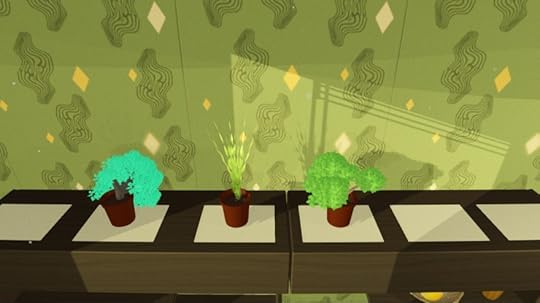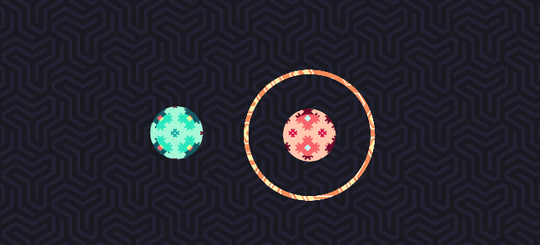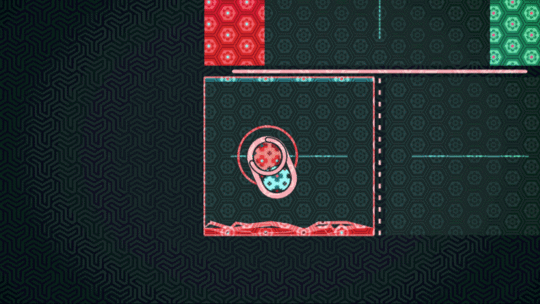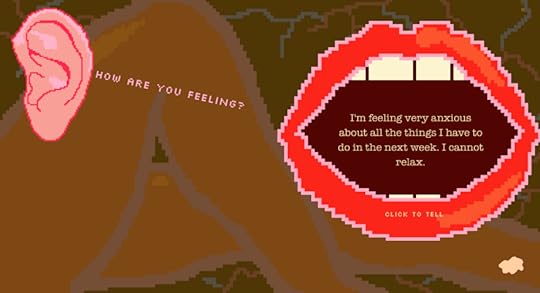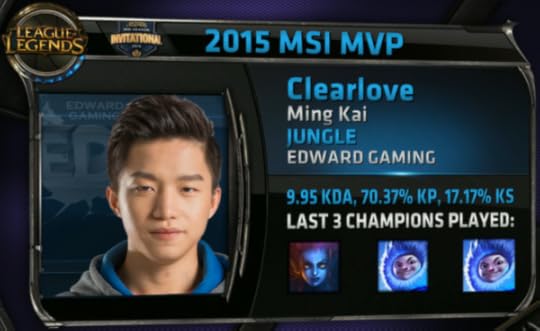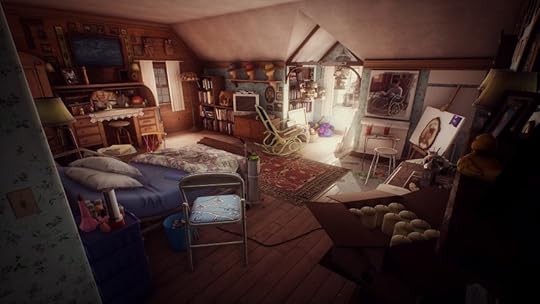Kill Screen Magazine's Blog, page 23
December 7, 2016
The invention of BARCHboi, the videogame deity
For the past couple of years, the digital artist and game maker known as BARCHboi has kept himself secretive. His primary online identity has been a logo of a portrait with a black bar across the eyes, overlaid with glitches. Now BARCHboi (real name: Joseph Dowsett) has made himself naked. His new “exploration glitchventure game” DEIDIA comes with an autobiographical making-of document that traces his creative history as far back as 2007, when he was 13 years old, going through all the struggles between then and now that brought him to make his latest interactive artefact.
The document is fascinating for a number of reasons. For aspirational game makers, it’s a valuable insight into one person’s early journey through making simple games to test different aesthetics and coding workarounds. No doubt there will be a bunch of artists and coders who can identify with the cycle of finding enthusiasm to try something new and the demotivation once it gets critiqued by others.
 It also shows Dowsett’s personal evolution as an artist, with a thorough rundown of all of his games, which comes with images and explanations for what he was trying to achieve with each one. What struck me most is how Dowsett demonstrates how his early mechanical experiments with Game Maker and exploration of visual styles (from pixel art to felt pens) all culminate to form a cohesive identity under the name BARCHboi.
It also shows Dowsett’s personal evolution as an artist, with a thorough rundown of all of his games, which comes with images and explanations for what he was trying to achieve with each one. What struck me most is how Dowsett demonstrates how his early mechanical experiments with Game Maker and exploration of visual styles (from pixel art to felt pens) all culminate to form a cohesive identity under the name BARCHboi.
“to create states of majestic relaxation and escapism”
It turns out there are many facets to that identity and being able to see how the individual components inform the whole is an insightful exposé. It’s rare that an artist who has such a strong and unique identity is willing to strip away the layers and show how others might similarly find their own persona, into which they can channel their creative interests. A lot of the BARCHboi identity can be seen within Dowsett’s 2014 game DEIOS, which is the predecessor to DEIDIA, and the game that brought him to my attention.
While working on DEIOS, Dowsett turned his interests in computer technology and culture of the ’80s and ’90s into his own style of music he dubbed Deitywave. He describes it as follows: “Deitywave contained 1980s synths mixed in with long reverbing sounds and pads; and was aiming to create states of majestic relaxation and escapism, inspired by films/ music such as the Never Ending Story, MGMT, Vangelis, and The Naked and the Famous.” There are aspects of this seen in his games, which are strongest in their visual style, developed over many years by Dowsett who experimented in MS Paint to arrive at the distinct rugged pixel-art strokes he’s known for.
“a hyper nature, hyper mechanical worldview”
Later, following a study into the Romantic movement in art, BBS and text terminals, and vaporwave, he invented the Barchian philosophy: “a hyper nature, hyper mechanical worldview. In which plants grew out of machines, people lived forever in data archives, no-one could ever become forgotten or truly die, and everyone could experience supreme power amongst technological fantasy software. A dystopian nightmare.” This is a core part of the BARCHboi persona and is what guides the aesthetic of the videogames released under that name.
Ultimately, DEIOS didn’t turn out the way it was initially planned to be, with many features being dropped. The document explains that Dowsett was disappointed in DEIOS and so went out to address its problems. The result after a lot of iterations is DEIDIA. No longer is Dowsett chasing gunplay and a huge, complex philosophical story—DEIDIA is BARCHboi playing to his strengths to deliver a memorable audiovisual experience. It’s a blend of noise and pixel art in which you explore an unstable land, where glitches can be opened up to explore new paths, finding forgotten ruins and abandoned terrain.
The making-of document isn’t essential for your enjoyment of DEIDIA, but I would say that it can help you appreciate and study it much better, mostly as you’ll understand the visual flourishes and the thinking behind it. To get the document, you’ll need to purchase the USB Edition from Deskpop at $20, which gives you the full game, the soundtrack, and the making-of document.
You can purchase DEIDIA for $9.99 on itch.io. The USB Edition is available for $20 on Deskpop.
The post The invention of BARCHboi, the videogame deity appeared first on Kill Screen.
This year’s best collection of experimental games is now on PC
If you didn’t get to play the Triennale Game Collection when it came out for mobile earlier this year then perhaps you’ll consider picking it up for PC. It came out for free on Steam today. It’s essential for anyone who is into interactive art or experimental games.
Put simply, the Triennale Game Collection is a package of five games, curated by the independent studio Santa Ragione—makers of MirrorMoon EP and Wheels of Aurelia. It was commissioned by the Milan-based museum La Triennale di Milano (hence the name) for its XXI Exhibition, the theme of which was “design after design.” I spoke to Santa Ragione co-founder Pietro Righi Riva earlier this year who told me that the museum had contacted him as “they wanted to cover modern videogames as one of the shapes taken by contemporary design.”
a friendship evolve over several days in a mysterious desert
The whole thing was put together over the course of about four months. Righi Riva reached out to some game makers he knew shared his and the museum’s design sensibilities, giving them a month to put together a prototype, and then another two months to make the whole thing—that gave Santa Ragione a month to wrap it all up into a single package.
There were some design constraints given to the designers due to the games being intended for a collection that would first be released on mobile, so no online play and no graphical interfaces were a couple of demands. “Other than that, the artists had full creative freedom,” Righi Riva told me. “We encouraged them to integrate some form of progression in the vignettes, so that players would be interested in exploring the games more than once, but it was not a strict requirement.”
It so happens that the five independent creators chosen by Santa Ragione are some of our favorites. The full list goes as follows: Mario von Rickenbach and Christian Etter (Dreii, Plug & Play), Tale of Tales (The Path, Sunset, Luxuria Superbia), Cardboard Computer (Kentucky Route Zero), Pol Clarissou (Orchids to Dusk), and Katie Rose Pipkin (Mirror Lake). In fact, the last in that list, Katie Rose Pipkin, features in Issue 10 of our print magazine, which is now available to order.
As to the games, you’re gonna want to check them out yourself, but I’ll give you some teasers. One tells the magical story of everyday objects that seems to combine stop-motion animation with tangible interactions like pulling on a cord. Another uses circular motion to navigate the many layers of Christian cosmology. The third sees a friendship evolve over several days in a mysterious desert where you can dig up various mundane treasures. There’s also a game that has you move through a dreamlike labyrinth uncovering memories. And the final one is an endless journey through generative greenhouses.
You can download the Triennale Game Collection for free on Steam. It’s also available on the App Store and Google Play.
The post This year’s best collection of experimental games is now on PC appeared first on Kill Screen.
How Virtual Reality will be used by doctors to treat patients
This article is part of a collaboration with iQ by Intel .
Earlier this year at Mount Sinai Hospital, Dr. Alfred-Marc Iloreta prepared for surgery by reaching for an unexpected tool. The otolaryngologist didn’t pick up his scalpel. He picked up a virtual reality (VR) headset. Iloreta’s patient had a brain tumor, located in a precarious area of the head, right behind his ear. This made the operation even more difficult. The surgeon needed to remove the tumor before it could grow further into the brain and wreak havoc.
Best known for use in immersive games and other-world entertainment, VR headsets could become an innovative tool for many industries, including the medical field. Iloreta strapped on an Oculus headset and booted up Surgical Theater, new software that creates a 3D model of the tumor. Now armed with a new form of visual information, he could plot out a plan for surgery and prepare for the intricate operation. “The tumors that we deal with are really complex… they exist in the middle of your head,” said Iloreta. He said VR surgery techniques can make a huge impact, especially for challenging cases. “Some of these approaches you are literally slicing someone’s scalp off.”
Worldwide, the number of annual inpatient procedures has grown to exceed 232 million. In America, between 100,000 and 200,000 of those patients die from mistakes. But experts believe that VR can greatly reduce the number of accidents on the operation table.It wouldn’t be the first time technology helped improve medical procedures. Doctors at the Hospital for Sick Children in Toronto recently designed a 3D printed heart to prepare for surgery on tiny valves. Surgeons at the Jacobs Institute were able to do a dry-run of a tricky aneurysm repair.
According to Ed Bradley, a professor of surgery at Florida State University, 4K cameras and robotic systems have become nearly as important as anesthesia and sterile practices when performing minimally invasive surgery. VR is poised to become equally valuable for more complex procedures.
VR surgery techniques can make a huge impact
Iloreta’s surgery was exceedingly delicate, as tumors in the middle of the head are surrounded by many tiny blood vessels. About 25 percent of the blood in the body flows through the headand one false move can result in heavy bleeding and stroke. Surgical Theater allows Iloreta to do dry-runs through complex surgeries before ever entering the operation room. The patient’s MRI and CT scan data gets fed into the digital simulation, where the doctors can analyze it naturally. “The goal, the anatomical nirvana, is where we can understand the whole structure three-dimensionally,” he said. “With immersive virtual reality, we can gain in-depth 3D understanding much quicker.”
This technology can also become a valuable education tool for training future doctors. According to Moritz Schwyzer, the CEO of Vedavi Medical who develops VR software for anatomical visualization, “VR gives students better understanding of the body’s plasticity and depth,” Schwyzer said. Students such as those Iloreta instructs at Mount Sinai can use it learn about the complex structures of human anatomy.
Iloreta said another huge benefit to VR technology is its potential to reduce medical costs for patients. The average cost of surgery in the US is around $62 a minute. Detailed prep and planning could cut down on time significantly. In addition to its potential to cut the cost of surgery, VR technology could help patients heal faster, according to Marissa Powers, the Venture Leadership Program Engineer at the forefront of Intel’s Project Alloy. Powers said VR might even help “gamify” physical therapy. For example, an injured athlete could use a VR headset and do rehabilitation exercises that make her feel like she’s playing hockey.
A study from Duke University and the Walk Again Project saw “unprecedented” results in training paraplegics to regain muscle control using a VR and exoskeleton setup, according to researcher Miguel Nicolelis, interviewed in Science Magazine. As more experts in the medical field see positive results from using VR technology, more believe it could become a reliable tool for improving and saving lives. Back in Iloreta’s real-world theater, his careful planning paid off. Despite the tumor’s proximity to critical structures, he removed it successfully, all with remarkably low trauma to the patient.
The post How Virtual Reality will be used by doctors to treat patients appeared first on Kill Screen.
December 6, 2016
The Botanist aims to bring people together through gardening
One night, James Biddulph couldn’t sleep, so he got up and made a quick garden generator on his computer. It worked by having you type in a word from which an abstract-looking plant would grow. He did this as the idea of having a garden has been his motivation in recent months. Biddulph is anticipating a move from a flat in the city to a house surrounded by a little more greenery with his fiancee. He can’t wait.
“Most of us spend a lot of time in cities, offices, busy, urban environments, pretty stressed out most of the time too,” Biddulph said. “Being in nature feels kind of the opposite to that, it’s calm, quiet, and a good place to switch off for a while and get some time to think.”
“Someone might think a plant is very chaotic, just like their friend”
Perhaps hoping that his tiny garden generator might help his friends in a similar way as it did him, Biddulph shared it with them. To his delight, many of them connected with it straight away. “Everyone did the exact same thing the first time that they played. They typed in their name, their friends, families, and pets names,” Biddulph told me. “Everyone also reacted in a similar way, seeing links between the plants and the names. Someone might think a plant is very chaotic, just like their friend.” That was all he needed to convince him to work on it for longer. Now he calls it this little project The Botanist.
[image error]
What struck Biddulph about his prototype and the reactions it got was how it got around one of the main problems of procedural generation: “you have near infinite stuff, [but] none of it has any meaning.” With that in mind, he wanted to develop his prototype into something that would help people connect with each other on a greater level. That’s where seed sharing comes in. The words you type in are used for the random number generator and affect a plant’s height, color, branch width, and other subtle variables. What this also means is that every player can type in the same word and get practically the same plant template as a result. “This is important, as it lets us share seeds,” Biddulph said. “If I find a seed that I like, I can let you know about it, and you can grow the same seed in your game.”
However, the plants can grow into different shapes—number of branches, where branches bend, number of flowers, the length of flower stems, etc. Having got my own bonsai tree this year, I’m surprised at how Biddulph’s plant generator parallels the ancient art, in which people channel meaning into their miniature trees through the pot shape and color, the root flare, the texture of the trunk, the bends in the branches, and much more. One of the most famous bonsai trees is Goshin, which is a small forest of bonsai trees, with each tree representing a spirit that would protect the artist’s grandchildren. In The Botanist, this act of dedicating a plant to a person in someone’s life can be made even more explicit given that you can use a name to create the plant in the first place.
Biddulph has since expanded The Botanist beyond its initial conceit, which involves generating plants and admiring them. The game starts with you losing your job, which is when you decide to become a botanist, trying to sustain yourself while doing something you love. Biddulph found himself in a similar situation a few years ago when he tried to make a living as a pixel artist and drew from it. “What I found was that the most important thing that I needed was a good reputation, with that you can make a living for yourself, so this is what I focused on in the game,” Biddulph said.
“I really want the game to be a positive experience”
What you do is work for clients who will ask for plants of certain types, colors, and variations. If you manage to fulfill the request you can take photos of the plants and send them over to the client. If they’re pleased with your work then your reputation will increase, which in turn unlocks different perks that’ll help your green fingers along. While making this part of The Botanist, Biddulph has made sure not to make it too stressful—that’s the opposite of what he’s after. “I really want the game to be a positive experience for players,” he said. “I don’t think that if the game had a strong resource management element in it or something and a player lost because they couldn’t pay this month’s rent it would give them anything positive, even though it is more realistic.”
That’s why you don’t have to keep track of money or pay for seeds in The Botanist. The only limitation is that you have to try to reach a certain reputation in a set time otherwise you’ll be forced to get another job, ending the game. The point of is to give some sense of progression to the game and encourage you to learn about and experiment with the plants. While the game only gives you five seeds at a time it does let you write about each one so you can keep track of the ones you like.
“If some players play this game and feel just a little bit happier, a bit less stressed, planting seeds that have names with happy memories, then I would feel like I’ve achieved what I wanted to,” Biddulph said. “If some players take away a bit of hope that they can get themselves out of a bad situation, maybe they can start that company, move to that new job, then that would be an incredible thing to do.”
You can find out more about The Botanist on its website. It should be coming to PC in early 2017.
The post The Botanist aims to bring people together through gardening appeared first on Kill Screen.
BOTOLO doesn’t want to be like other competitive videogames
Ian Snyder is responsible for making one of my favorite games of 2014: The Floor is Jelly, a side-scrolling platformer that makes jumping more playful than ever. So many game makers try to reinvent the platformer by tweaking the jump—the distance, the speed, or the friction perhaps. But Snyder went another way and changed the world around the jump. It worked wonderfully.
For his next game, Snyder has taken this same unique, if simple, approach to exploring a new avenue in an established genre, and applied it to competitive multiplayer games. Called BOTOLO, it’s due out for Windows and Mac on December 15th. It doesn’t look like many other competitive games, nor does it think anything of playing fast and loose with the foundations of the type. As Snyder describes it, BOTOLO is “a fast paced mindreading competition,” and a “dance inside the negative space between your opponent’s thoughts.”
“Everything that happens in BOTOLO is a sum”
Snyder started out with an interest in the experience of playing competitive games at a high level. But he also wanted to see how much you could strip from competitive games before they became uninteresting or dull. “I wanted to throw fighting games in a pot and turn up the heat until all the water and everything that wasn’t Fighting Game boiled away,” Snyder told me. Alongside this, he was looking to forego the necessity for skill in a competitive game—in his words, “the game should not be difficult to play.” The results didn’t quite connect with people in the way he was hoping for at first, so he spent the next two years honing the game until his small experiment turned into BOTOLO.
At its most basic level, BOTOLO is a game in which both players are after a ball, which they need to bring it to designated zones and hold it there to win that zone, while always trying to prevent their opponent from snatching the ball from them. But the heart of BOTOLO is prediction. “Any given event in BOTOLO is the combinatorial result of both players making predictions about the other player, independent of one another,” he said. “Everything that happens in BOTOLO is a sum, and each player is only half of the full equation. This means that, although they are thinking and scheming alone, it should be (mostly) impossible for either player to act alone. There should be no way they can ‘opt out’ of the equation, no null action they can take.”
Snyder has clearly thought a lot about “null action” and its role in videogames so that he can subvert it. He describes the “feel” of a game as being defined by the rhythm of acting and resting, i.e. when you’re performing an action and when you’re not. Null action is this resting period and it’s there to let you catch your breath. Snyder wanted to make a game that reduces null action to nil, but that’s very hard. “The only way around, as far as I can tell, is to make the null action something done only with intention and planning, rather than done passively,” he told me.
a form of dance based on tension and timings
This is why Snyder posits the “central decision loop” of BOTOLO is a choice of acting and waiting. It’s a game about waiting for the right moment to strike, to steal the ball from your opponent, or if you have possession, to block an attack. The steal and block maneuvers are the pivots for the rest of the game. Both moves require the player to hold the action button down to perform either a block or a steal. The defender wastes shield during a block, however, with the complete depletion of the shield rendering them entirely vulnerable for a couple of seconds. But a well-timed and therefore successful block scores the defender points.
As the risk is high for both players to commit to these actions what you tend to see is both of them prodding or waiting until one of them opens themselves up. This is something that Snyder recognizes as a form of dance based on tension and timings. “Generally, the hardest thing for new player to learn about BOTOLO is that waiting is something you have to do intentionally, and once that realization occurs the rest of the game quickly clarifies itself,” Snyder said. “The whole thing is pinned upon these null actions. If you can intuit the natural rhythms at which your opponent stops to think, you’ll be miles ahead of them already.”
The other major way that Snyder subverts the tradition of competitive games is through BOTOLO‘s visuals. Each level is a top-down arena divided by sharp lines and contrasting zones of patterns. He told me he has difficulty connecting with the hyperbolic aesthetics of most fighting and competitive games in which characters can often be identified as “a floating orb of miscellaneous muscles.” He opted for a different look for BOTOLO as he’s “interested foremost in how to make a game look good given the constraints of its design as a whole.” This is why, rather than making a character-based game he thought of the visuals in terms of texture.
“I’d experimented previously with these screenspace patterns in Thirteen Gates, and it was a visual aesthetic to which I’d always wanted to return. Given the abstract nature of this game, this seemed a good opportunity. BOTOLO, mechanically, is about abstract thought and identifying patterns in your opponent’s play, so there’s a harmony in making the game’s visuals a patterned abstraction.”
The big issue that Snyder may face given that BOTOLO doesn’t have online multiplayer (only local multiplayer and a single player mode), as well as its unconventional ideas and looks, is that it may struggle to find a large audience. That said, it has already been used for a tournament at Fantastic Arcade 2015, and Snyder only has hopes that it will become a frequent shower among tiny competitive communities. It is an esport after all. “These smaller communities may be more fractured than international franchises; their players, instead of winning thousands of dollars, might win the $20 everybody here pitched in, or the right not to do the dishes for a week, or even just the pride of knowing they’re better at BOTOLO than their friend, but whenever and wherever two people play BOTOLO, BOTOLO is alive.”
You can find out more about BOTOLO on its website. It also has a Steam page and will be available on December 15th.
The post BOTOLO doesn’t want to be like other competitive videogames appeared first on Kill Screen.
Videogames about self-care are exactly what we need right now
In the days following the results of the American election, programmer and game maker Jessica Hayley considered running a “Fuck Trump Game Jam” in order to “channel [her] anger into something that felt productive.” But upon reflection, she realized that the games that would come out of such a move would likely be something she wouldn’t want to contribute to.
“I still wanted to do something, but I didn’t want the outcome to be a bunch of hateful games,” Hayley told me. “So I decided to turn the idea on its head and make a jam where the goal is to create some positivity to counteract the anger, to remind us to take care of ourselves even when terrible, hateful things keep happening.” That’s how she got the idea for the Self-Care Jam, which ran from November 28th to December 5th.
“let’s make stuff that makes us happy”
The Self-Care Jam had a wonderful, refreshing simplicity to it: “let’s make stuff that makes us happy” reads its only rule. Participants were encouraged to create inside whatever format that fulfilled that instruction, whether it was a videogame, a poem, a comic, music, crafts, or anything else. The entries didn’t have to be about self-care, as the jam is meant as a reminder that “the process of creating something can be a form of self–care by itself” according to Hayley, but many of them did turn their attention to the subject of self-care anyway.
Jordan Mallory made the old life EP, which is said to be a collection of “sad songs for hurt people.”Alayna Cole created a Twitter bot under the handle @selfcare_bot that tweets hourly reminders for people to look after themselves. While Bri Rodgers released an interactive poem called this year i’ve been about “being alive and taking care of yourself.” There’s also the game It’s a Beautiful Day by Julie Yllogique, which is about taking care of yourself in the morning before you face the world (I can so identify with having long, hot showers in the morn).
The team led by Lisa Janssens took a slightly different approach to the topic, creating a game called Losing Control, which is about the importance of negative emotions. “I wanted to create this game as a reminder to myself that feeling bad isn’t necessarily a bad thing, that those feelings have importance and that they aren’t permanent,” Janssens wrote.
press a button to lie down when you find a cozy space
The idea of a videogame about self-care isn’t entirely new. Lullaby for Heartsick Spacer (2014) by Merritt Kopas is one of the first I can remember. Inspired by Super Metroid (1994), Kopas described it as “a game for when you feel like you want to crawl into a cave on an alien planet and hide and sleep.” You explore procedurally generated caves and press a button to lie down when you find a cozy space. There are also the games of Kara Stone, many of which focus on self-healing, especially Medication Meditation (2014) and Cyclothymia (2015).
Another big part of this direction that some game makers are moving in is the website Soft Chambers. Started in 2015, it is dedicated to writing about and curating games concerned with care and tenderness. Its list of verbs that are uncommon in videogames and that it is interested in is particularly handy: caring, nurturing, growing, communicating, embracing, giving, resting. A couple of games that have been made in lieu of Soft Chambers include last year’s Minkomora and Orchids to Dusk.
The Self-Care Jam helps to bring more awareness to this side of videogames, where people make games to heal, and don’t need to worry about profits or target markets. “As more ways to get funding in game-agnostic ways (such as Patreon) pop up I can only hope that more and more developers find themselves in a place where they are able to do this consistently,” Hayley said.
You can check out all the entries to the Self-Care Jam on itch.io.
The post Videogames about self-care are exactly what we need right now appeared first on Kill Screen.
Memories of a failing relationship are made beautiful in Ephemera
Plenty of things in life have expiration dates: cartons of milk, your passport, antiperspirants. After a week in the fridge, you should really retire that open bottle of wine. Relationships, on the other hand, don’t usually come marked with an end date. You might see the end coming from a ways away, but the ‘when’ is, in most cases, unclear.
Not so in Ephemera (French: Les éphémères), a new narrative experience currently in development by Interim Studio. Designed by Lazlo Bonin and animated by Jazz Eladas, Ephemera is a “notgame” in which you have one fleeting summer to spend with your love before she leaves in September.
Your actions dictate how you will remember this final summer
You get to choose between lingering on your memories of her, bringing the past to life with splashes of watercolor in a pristine white world, or live in the moment and enjoy your dwindling time together. Looking through her silhouette, the world is filled with color. Ephemera’s unique, painterly art style sets the game’s wistful tone, visualizing what it is to feel that life lights up in the presence of a certain person and how color is leached out when that person goes away.
Your actions dictate how you will remember this final summer: piece together your days through impressionistic vignettes, captured on film or painted with ink. Voiced in Quebec French, this second-person narrative unfolds like a work of art, exploring themes of time, memory, and loss.
Keep up with Ephemera’s development at its website or on Steam.
The post Memories of a failing relationship are made beautiful in Ephemera appeared first on Kill Screen.
From Maverick to League of Legends Team Leader
This article is part of a collaboration with iQ by Intel .
As Ming “Clearlove” Kai evolves from an aggressive risk-taker to an eSports team captain, his trusty gaming PC remains a portal to becoming a consistent leader. Kai’s competitive League of Legends (2009) career has kept the eSports community on their toes. Notorious for his unpredictable boldness, the daredevil now seeks to find stability as Edward Gaming’s (EDG) gifted captain. After being named ESPN’s top jungler at this year’s World Championship, empowered by both the support of his teammates and powerful practice rig, hope runs high that Clearlove will lead EDG to victory.
He’s certainly qualified. At his first League of Legends (LoL) Pro League in 2014, Clearlove snagged the top spot in the MVP ranking after some nail-biting battles. In LoL, two teams of five face off against each other from opposite corners of the map in an attempt to destroy the other’s base. Usually, teams duke it out in either the top, middle or bottom lanes that split up the Summoner’s Rift map. To start, teams gain power by accumulating gold and experience points, giving players who secure early kills and cut their opponents opportunity short an advantage.
Like two boxers trying to land blows without losing too much ground, many LoL teams wait for the perfect moment before committing to a fight. But as a team with excellent execution, EDG often tries to force fights early. When opponents evaded the tactic in the 2014 playoff semifinals, Clearlove stumbled. But after opponent Xu “17″ Zhao made one misstep, drifting just a little too far out of his team’s defenses — and Clearlove revealed his true colors.
As a jungler, Clearlove plays the wild card position, roaming the map searching for fights. When 17 pushed his luck, Clearlove pounced, securing an early kill that helped snowball his team into victory. But the 2014 World Championship was a .
Shooting to a top position in the tournament at first, EDG went on to lose 3-2 to team Star Horn Royal Club (SHRG). In a close game five, EDG’s early lead dwindled after several messy slugfests went south. Poor organization on EDG’s part helped SHRG edge its way back into the match, culminating in a late game march up the bottom lane. When the wave finally broke against EDG’s base, Clearlove was the first to fall. “The end is also the beginning,” Clearlove declared at the time, dejected but optimistic for the future.
The end is also the beginning
These erratic performances — wavering between ruthlessness and uncertainty — have haunted Clearlove for most of his eSports career. While he’s adept at turning moments of crisis into opportunities, finding some level of balance in the chaotic play is crucial for his team going into Worlds this year. But one constant has driven Clearlove ever since he first began playing LoL in 2011: his love of competition.
“What hooked me the most about LoL was the tournament aspect,” he said. The thrill of matching wits, skill and experience against opponents fuels Clearlove’s play style, which focuses heavily on team fights. Nicknames like “Promise” and “Director Nuo” sprung from early commentators who said he resembled a director controlling enemies like they were actors. But now, Clearlove seeks to direct his team in a much more collaborative way. “The foremost thing is trusting each member,” said Clearlove. “We have to listen to the opinion of others in order to make a precise evaluation.”
Moving from daring rogue to wise team leader, Clearlove’s emphasis on trust and communication can be seen in recent matches. Wiping out an entire enemy team is no easy task, but that’s what Clearlove did at a 2 vs. 5 pentakill executed against GT, during the Demacia Cup. With teammate Mouse running for dear life after baiting his opponents, Clearlove swooped in to reverse the fight. While an ability boost helped, it was the tight coordination with Mouse, not to mention the latter’s willingness to self-sacrifice for the group, that made the play a success.
Clearlove said that good communication, including real-time strategic advice, was key to the swift annihilation. Without faith in one another’s judgment, their well-timed attack could have quickly turned into an unforced error and a boon for the enemy team. This shift toward open communication even led EDG’s coach, Ji “Aaron” Xing, to rave to The Score that, while “every pro player has to be gifted, from my perspective, Clearlove is very gifted.”
Previously, the two played together on Team WE. Their shared history and dedication to perfection, along with a mutual respect for one another, make Xing and Clearlove ideal collaborators. “We learn from each other, and we grow with each other,” said Clearlove. But navigating setbacks remains a top concern. Despite EDG dominating its 2015 Summer Season, the team faltered in the playoffs, only securing a place at Worlds 2015 through the Regional Finals.
Through these ups and downs, Clearlove has remained steadfast on improving. Clearlove views his “failures” as opportunities to reflect then double down on training. “I can say I have won many championships in my career, but I feel I haven’t reached the peak of my career yet at heart.” During the grueling hours of practice, he turns to a reliable companion: his gaming rig.
Clearlove remembers his first underpowered gaming PC, which he bought with savings when he was just a high school junior. Today, he sports an Acer Predator series with the latest Intel Core i7 processor and NVIDIA GeForce GTX 980. “It’s robust enough for me to run LoL on the highest performance setting, but also lets me stream smooth gameplay without any lag,” he said.
Clearlove is growing into his role as “the shotcaller”
Having a dependable rig is of utmost importance to Clearlove in the tense weeks leading up to Worlds. It helps him keep his mind focused on the game not the technology. “At this moment, emotional self-regulation is extremely important to me as an eSports athlete.”
Clearlove believes the key to remaining on top is learning to grow, adapt and evolve both with the technology and ever-changing tides of the eSports scene. After winning a thoroughly dominant 3-0 series against Chinese rivals Royal Never Give Up in the 2016 LPL finals, the EDG stalwart reached a new level of maturity. Whether EDG has what it takes to compete on the biggest LoL stage, however, is still open to debate. As Clearlove grows into his role as the shotcaller, modifying strategy to boost each player’s individual strengths, he’s focused on making fewer missteps. “I am hopeful EDG’s performance will only get better from here.”
The post From Maverick to League of Legends Team Leader appeared first on Kill Screen.
December 5, 2016
Oh yes, there’s a storm coming alright, and it’s called Vane
It’s been a while since we’ve had any news about Vane, a game that has defined itself by a kid running across a stormy desert, ancient temples, and a crow flying overhead. That changed on Saturday night as, during the PlayStation Experience in LA, a new trailer was released for the game, and it shows off some new sights at last (still lots of desert, mind you). It’s also been confirmed for PlayStation 4 in 2017.
Friend and Foe, the Tokyo-based creators of Vane, also put out some new descriptions of the game, updating the ones from 2014. That seems to be a good place to start. One of the new descriptions reads as follows: “Discover a strange land with a hidden mystery. Explore the secrets of the past to find the remnants of your future,” and, ominously, the final line is, “The storm is coming.”
The gist of the game is that you’re playing as a kid who is trying to discover their place in the world, and to do that before the threat of this storm arrives. It’s implied that the temples have power that can alter the land—pay attention to the sped-up footage in the trailer—and that the kid will be making use of them as they are pull “at the threads of the world to make a change.”
Below you’ll see a bunch of new screenshots, many of which emphasize the scale of these huge temples as seen from the exterior, and a couple that give us a look at what can be found inside. Gigantic stone pillars are big sets of stairs are frequent sight inside these temples, but the most eye-grabbing feature in these temple interiors is the carved dome-like rock with raised platforms in a ring around it in one of the shots. Perhaps a piece of ancient technology or an instrument for a magical ritual, perhaps?
My best guess is that the temples can be manipulated to harness the power of the encroaching storm. Another defining feature of the game are the esoteric weather vanes that are scattered around the desert—it’s called Vane after all. I get the impression that the kid is fated to reignite some old technology that was built by their ancestors to save the desert as it nears destruction, by turning the very forces that would rip it apart to their favor. But that’s completely a guess.
Come up with your own theories by watching the new trailer above and scanning the screenshots. Look out for more info on Vane on its website.
The post Oh yes, there’s a storm coming alright, and it’s called Vane appeared first on Kill Screen.
Get a quick peek into the strange house of What Remains of Edith Finch
After it was revealed last week that Annapurna Interactive would be publishing What Remains of Edith Finch in spring 2017 for PC and PlayStation 4, a new trailer for the game was revealed during PlayStation Experience on Saturday night.
If you don’t know, What Remains of Edith Finch follows the titular girl as she discovers the stories of her past family members and how they came to die. It’s an exploration game set inside the bizarre Finch household but also transports your perspective back into these older stories, which range from the 1900s to present day. Edith is trying to find out why she’s the last Finch alive.
the stories to be found in these bedrooms are “hard to believe”
The trailer, which you can watch below, gives a little more insight on the background story. We find out that Edith lived in her family’s home until she was 11 years old but wasn’t allowed inside many of the rooms. She had a brother called Milton who, at one point disappeared, which encouraged her mother to lock up many of the rooms in the house.
Specifically, it’s the bedrooms that Edith was disallowed from seeing. It seems that we’ll be joining an older Edith who has returned to the house of her childhood to find out what’s inside those rooms. In the trailer she says that many of the stories to be found in these bedrooms are “hard to believe,” which is pretty much the point of the game. As we found out before, the creators of the game at Giant Sparrow have been inspired by Japanese ghost stories and aim for the game to be “mysterious, unsettling and strange.”
Watch the trailer above, see new screenshots below, and look out for more info on What Remains of Edith Finch on its website.
The post Get a quick peek into the strange house of What Remains of Edith Finch appeared first on Kill Screen.
Kill Screen Magazine's Blog
- Kill Screen Magazine's profile
- 4 followers








